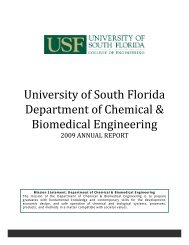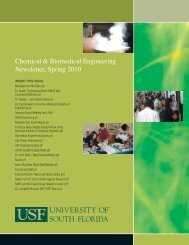2007 - Chemical & Biomedical Engineering - University of South ...
2007 - Chemical & Biomedical Engineering - University of South ...
2007 - Chemical & Biomedical Engineering - University of South ...
Create successful ePaper yourself
Turn your PDF publications into a flip-book with our unique Google optimized e-Paper software.
Faculty and Research Interests<br />
Dr. Norma A. Alcantar<br />
Assistant Pr<strong>of</strong>essor<br />
alcantar@eng.usf.edu<br />
(813) 974-8009<br />
website: http://www.eng.usf.edu/~alcantar<br />
Education:<br />
Post-Doctoral Research in Materials Science, <strong>University</strong> <strong>of</strong> California, Dept <strong>of</strong> Chem.<br />
Eng & Mat Sci/UC Davis & Mat Res Lab/UCSB, CA, USA.<br />
Ph.D in <strong>Chemical</strong> <strong>Engineering</strong>, <strong>University</strong> <strong>of</strong> California at Santa Barbara, 2000.<br />
B.S. in <strong>Chemical</strong> <strong>Engineering</strong>, National Autonomous <strong>University</strong> <strong>of</strong> Mexico (UNAM),<br />
Mexico City, Mexico.<br />
Research Interests: Surface Forces and <strong>Chemical</strong> Characterization <strong>of</strong> Biomimetic<br />
Membranes, Amyloid Beta Peptides, Micellar Surfactants, <strong>Chemical</strong>ly Active<br />
Surfaces, Natural Materials, and Drug Delivery Systems.<br />
Using natural materials to produce safe drinking water<br />
Waterborne diseases from pathogens<br />
and contaminants afflict a majority <strong>of</strong> the<br />
World’s population, especially in<br />
developing countries. A major victory in<br />
the battle against infectious and chronic<br />
diseases can be won if safe drinking water<br />
can be made available for people<br />
irrespective <strong>of</strong> their economic conditions.<br />
Basic understanding <strong>of</strong> the local customs<br />
and attitudes regarding water use is<br />
required to design and implement a<br />
Nopal Cactus Plant:<br />
Opuntia ficus-indica<br />
technology using locally obtainable, natural materials that can provide<br />
clean drinking water to low-income communities in such pressing need.<br />
The long-term goal <strong>of</strong> this research project is to develop, implement,<br />
and test a culturally appropriate, economically viable, and environmentally<br />
and socially sustainable “green technology” for water purification using<br />
cactus mucilage in rural and developing communities <strong>of</strong> Mexico, which<br />
have been exposed to polluted drinking water and where access to<br />
conventional filtration technology is limited. Funding Source: Sustainable<br />
Communities: Water Project, USF-State <strong>of</strong> Florida.<br />
Systematic Study <strong>of</strong> Amyloid Beta Peptides: Implications for<br />
Alzheimer’s Disease<br />
This research project examines how<br />
antibodies against amyloid beta (Aß)<br />
peptides modify the process <strong>of</strong> aggregate<br />
formation, the corresponding changes in<br />
conformation, and the time-lines related<br />
to the antibody- Aß interactions. By<br />
studying the effects <strong>of</strong> amyloid peptides<br />
with 40, 42 or 41 amino acid sequences,<br />
both separated or combined, will allow<br />
one to understand the effects <strong>of</strong> length<br />
and end group <strong>of</strong> the peptide.<br />
The long term objective <strong>of</strong> this work is<br />
to identify the extent to which antibodies<br />
can modify Aß secondary structure and<br />
determine what the impact <strong>of</strong> this<br />
mechanism might be in relation to other<br />
mechanisms in mouse models and<br />
patients. Funding source: Rinat-Pfizer.<br />
Amyloid-β Peptide Fibrillar<br />
Assembly as Seeing using<br />
Atomic Force Microscopy<br />
(Scan size: 10µm x10µm).<br />
Recent Research Projects<br />
‣ Conducting and Semi-transparent<br />
<strong>Chemical</strong>ly Active Surfaces<br />
‣ Antibody Mediated Conformational<br />
Changes in Aß Peptides<br />
‣ Critical technologies and strategies<br />
for meeting the UN’s Millennium<br />
Development Goals on water and<br />
sanitation<br />
‣ Study <strong>of</strong> the Flocculating Capacity<br />
<strong>of</strong> Nopal Mucilage<br />
‣ Transforming the Educational<br />
Experience <strong>of</strong> Transfer Students in<br />
<strong>Chemical</strong> <strong>Engineering</strong> using a<br />
Multi-Dimensional Approach<br />
‣ Drug delivery systems for cancer<br />
patients<br />
Recent Publications and Patents<br />
Anzalone, A., Boles, J., Greene, G., Young,<br />
K., Israelachvili, J., Alcantar, N., Confined<br />
Fluids and their Role in Pressure Solution.<br />
<strong>Chemical</strong> Geology, 2006. 230 (3-4):220-<br />
231.<br />
Jiménez, J., Heim II, A., Matthews, G.,<br />
Alcantar, N., Construction and<br />
Characterization <strong>of</strong> S<strong>of</strong>t-Supported Lipid<br />
Bilayer Membranes for Biosensors.<br />
Application <strong>Engineering</strong> in Medicine and<br />
Biology Society, 2006. No. EMBC061976.<br />
Dearborn, K., Toomey, R., VanAuker. M,<br />
Hood, E., Alcantar, N., Niosome drug<br />
delivery systems containing nanoparticles<br />
embedded into biodegradable polymer<br />
hydrogels. PCT Int. Appl. (<strong>2007</strong>), 12pp.<br />
Patent: WO <strong>2007</strong>123993.<br />
Young, K., Anzalone, A., Pichler, T., Picquart,<br />
M., Alcantar, N.: The Mexican Cactus as a<br />
New Environmentally Benign Material for the<br />
Removal <strong>of</strong> Contaminants in Drinking Water<br />
in Materials Science <strong>of</strong> Water Purification,<br />
ed. Shannon, M. et al., 2006, 0930-JJ01-01.<br />
6





